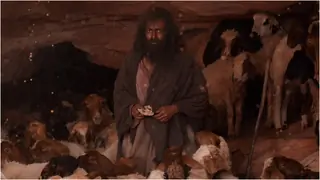Battle for Chitor: Storming the Last Hindu Fortress in 1567
The opening phase of battle began when some overzealous Mogul troops launched a reckless direct assault upon the fort. Not surprisingly, the Moguls' arrows and bullets glanced off the surface of the walls and battlements, whereas those the garrison discharged exacted a heavy toll on them.
After that minor debacle, Akbar decided that strategic planning rather than reckless courage (unfortunately cv's have shown Akabr army more reckless than King)was what was needed if the fortress was to be taken. Accordingly, the emperor adopted a two-pronged strategy. One entailed mining the walls of the fort in front of the royal battery, whereupon a party of selected Mogul troops would rush into the fort as soon as the breach was made. While the sappers dug mines under the walls, stonemasons opened the way by removing obstacles with their iron tools.
The other strategy called for the construction of sabats, or covered passageways, an ingenious siege contrivance that was peculiar to India. A sabat was a sinuous sheltered passageway that was constructed out of gunshot range, with earthen walls on both sides and a roof of planks strongly fastened together and covered with rawhide. When a breach was made by mines, troops would rush in under the cover of the sabat. Akbar ordered the construction of two sabats: one to be commenced from the royal battery and the other to be built in front of Shujaat Khan's position.
At the same time, in the emperor's presence, an exceptionally large mortar was cast to demolish the walls of the fort. When the defenders became aware of this and saw that the Moguls were making daily progress toward the destruction of the fort, they sent out two representatives to Akbar to bargain for peace, offering to become subjects of his court and to send an annual tribute. Several Mogul officers advised him to accept the offer, but Akbar was adamant: Nothing short of the rana surrendering in person would persuade him to lift the siege. As they were unwilling-or perhaps unable-to deliver the rana, the Rajputs had no choice but to continue the defense of their fort with renewed fervor.
While the sabat in front of the royal battery was being constructed, artillerymen and marksmen inside the fort kept up such a fusillade that about 200 Mogul laborers were killed daily, even though they protected themselves with rawhide shields. The corpses were buried in the walls of the sabat. But the workers were kept going by lavish gifts of gold and silver coins from the emperor(i must say this cv's have shown very properly)-the amount of which was calculated according to the number of containers of earth added to the sabat. The sabat opposite Akbar's position was soon completed near the fort. It was reported to be so extensive that 10 horsemen abreast could ride along it and so high that an elephant rider with his spear in his hand could pass under it.
At the same time, two mines close to each other were brought to the wall of the fort and filled with large quantities of gunpowder. A party of fully armed and accoutered Mogul soldiers, noted for their bravery, stationed themselves near the wall, ready to rush in when it was breached. On December 17, the gunpowder of both mines was set to explode at the same time.( i am eagerly waiting to see this)One part of the bastion was blown up, inflicting heavy casualties on the defenders. Unknown to the Moguls, however, only one mine had exploded. When the soldiers rushed toward the large breach and were about to enter, the second mine exploded (apparently, the match used to ignite the gunpowder of the mine that exploded first had been shorter than the other match, so the mines failed to discharge simultaneously).
(After today's epi it is certain Rajputs will reach the mughal's tent , though Pratap wants to kill Akbar , which certainly does not happen- well this is histort so may be Rajputs could be behind this explosion explosion happened how is a question mark??? afterall khali haat to nahi aya Kuwar Pratap may be we will see this agar aj nahi to kaal hi saayi)
Moguls and Rajputs alike, battling in the breach, were hurled into the air together, while others were crushed by falling debris. The blast was so powerful that limbs and stones were hurled a great distance from the fort. Mogul reinforcements and Rajput troops then engaged in a brief skirmish until the Rajputs succeeded in quickly repairing the demolished part of the wall. About 500 Mogul soldiers, including a significant number of noteworthy men, were killed, while a large number of Rajputs also perished. On the same day, another ill-timed mine exploded in front of Asaf Khan's battery and claimed 30 more lives.
Akbar viewed these botched undertakings as temporary setbacks that should serve to inspire even greater exertion and resolve on the part of the Moguls. To ensure that the assault on the fort would continue unabated, he ordered the construction of the sabat in front of Shujatt Khan's battery to be speeded up.
The emperor also frequently visited the sabat in his sector and fired at the garrison from loopholes in the sabat. One day, Akbar saw that some of his men were admiring the marksmanship of one of the musketeers of the fort when, at that very moment, a shot from that marksman hit Jalal Khan, one of Akbar's attendants. Akbar was reported to have said to his injured attendant, Jalal Khan, that marksman does not show himself; if he would do so, I'd avenge you. Although he could not see the marksman, Akbar took aim at the barrel of the musket that projected from a loophole. He fired but could not determine whether his shot had found its mark. It was only later that Akbar learned that his shot had indeed killed the sharpshooter, who was identified as Ismail, head of the musketeers.
Akbar proved to be quite a marksman himself, killing many noted members of the garrison. But the emperor also came close to losing his own life on a few occasions. Once, a large cannonball that fell near Akbar killed 20 soldiers but left him unscathed. On another occasion, a soldier standing near Akbar was hit by a bullet, and the emperor was saved from the same round only by his coat of mail.
When the second sabat was completed, the Mogul forces prepared to launch a full-scale assault on the fort. The Mogul troops went about their operations with such vigor and intensity that for two nights and a day they had neither food nor sleep, inspired by the personal example of Akbar, who was supervising the operations and keeping up a fusillade upon the garrison from the sabat. Special quarters had been erected for Akbar on top of thesabat, and the emperor stayed there during this crucial period.
On the night of February 22, the Moguls attacked the fort from all sides and created several breaches in the walls. The Rajput warriors put up a stubborn resistance. At one point in the fighting, Prince Patta's mother commanded Patta to don the saffron robe, which would indicate his desire to die for his gods and his country. She also armed his young bride with a lance and accompanied her down the rock. The defenders of Chitor saw mother and daughter-in-law die heroically, fighting side by side. - See more at: http://www.historynet.com/battle-for-chitor-storming-the-last-hindu-fortress-in-1567
I salute these great patriotic soldiers of chittor, their sacrifice and bravery.


























